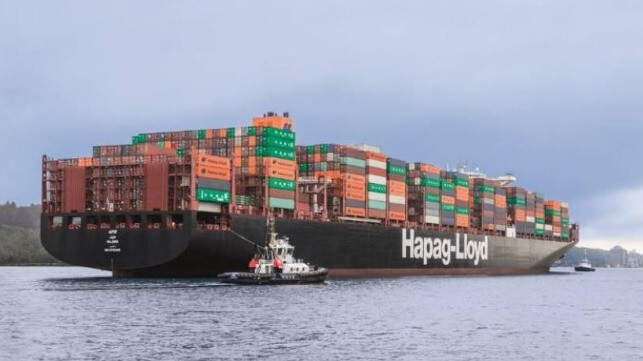Hapag’s Profit Triples While Cautioning Container Market has Peaked

As the latest demonstration of the ongoing strength in the container shipping markets, Hapag-Lloyd reported a better than 80 percent increase in revenues while group profits more than tripled to $4.7 billion despite flat volumes during the first quarter of 2022. While saying that the second quarter would be ahead of forecasts due to the strength of long-freight rates, Hapag cautioned that the market has peaked saying it expects a normalization is coming.
“The year has got off to an exceptionally strong start on the whole, and while there have been first signs that the market has passed its peak, we also expect a strong second quarter,” said Rolf Habben Jansen, CEO of Hapag-Lloyd. He however also pointed to current market factors including Russia’s war in Ukraine, which is putting further strain on the already disrupted global supply chains, as well as China’s COVID-19 policies that were impacting port and logistic activities. He also noted that spot rates were softening as a result of seasonality and lower volumes.
During the first quarter of 2022, Hapag like other major carriers highlighted that volume growth has slowed. The German carrier reported flat volumes of just under three million TEU, level with the first quarter a year ago. Freight rate increases however drove the performance with Hapag reporting 84 percent year-over-year growth in revenues, reaching nearly $9 billion, and contributing to the company raising its forecasts for the second quarter and the whole of 2022. Hapag is now forecasting earnings of between $12.5 and $14.5 billion (EBIT) in 2022.
Despite the strength in rates, Hapag also discussed a range of operational issues which are putting the company under increasing pressure. They highlighted that many ports are still congested, and hinterland infrastructures are strained, which together is resulting in longer turnaround times for ships and containers. They are also being impacted by significantly increasing expenses for container handling and a roughly 60 percent higher average bunker price, rising from $384 per ton in 2021 to $613 per ton this year.
“Global supply chains continue to be under significant pressure – not least because of the recent measures taken in China in response to COVID-19 outbreaks. This situation is expected to improve in the second half of the year. For our customers worldwide, we will do everything in our power to help normalize this difficult market environment as quickly as possible,” said Habben Jansen.
In addition to new long-term and multi-year freight contracts which the company believes will provide protection from falling spot rates, he pointed to steps being taken in the operations. Hapag has started a fleet upgrade program with propeller refits to increase fuel efficiency and they are rolling out a real-time tracking system for containers to improve visibility across their system. Noting that industry-wide idle fleet levels remain low, Hapag said it is actively managing its charter vessel portfolio and purchases of secondhand vessels.
While expecting the volumes will remain flat for the remainder of 2022, Hapag-Lloyd believes that strong contract freight rates will more than offset increases in bunker fuel and operating costs contributing to its 12 percent increase in its earnings forecast for the year.
